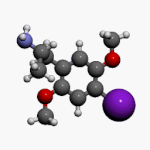2,5-Dimethoxy-4-iodoamphetamine
 | |
 | |
| Names | |
|---|---|
| Preferred IUPAC name
1-(4-Iodo-2,5-dimethoxyphenyl)propan-2-amine | |
| Identifiers | |
| |
3D model (JSmol)
|
|
| ChEMBL | |
| ChemSpider | |
PubChem CID
|
|
| UNII | |
CompTox Dashboard (EPA)
|
|
| |
| |
| Properties | |
| C11H16INO2 | |
| Molar mass | 321.1558 g/mol |
| Melting point | 201.5 °C (394.7 °F; 474.6 K) (hydrochloride) |
| 10 mg/mL[1] | |
| Pharmacology | |
| Legal status |
|
Except where otherwise noted, data are given for materials in their standard state (at 25 °C [77 °F], 100 kPa).
| |
2,5-Dimethoxy-4-iodoamphetamine (DOI) is a psychedelic drug of the amphetamine and 4-substituted-2,5-dimethoxyamphetamine (DOx) families.[3][4]
DOI acts as a potent serotonin 5-HT2 receptor agonist.[3][4] DOI has a stereocenter and R-(−)-DOI is the more active stereoisomer. In neuroscience research, [125I]-R-(−)-DOI is used as a radioligand and indicator of the presence of serotonin 5-HT2A receptors.[3]
DOI's effects have been compared to LSD, although there are differences that experienced users can distinguish. Besides the longer duration, the trip tends to be more energetic than an LSD trip, with more body load and a different subjective visual experience. The after effects include residual stimulation and difficulty sleeping, which, depending on the dose, may persist for days.[5] While rare, it is sometimes sold as a substitute for LSD, or even sold falsely as LSD, which may be dangerous because DOI does not have the same established safety profile as LSD.[6]
DOI was first synthesized in 1973, by Coutts and Malicky.[3]
Pharmacology
[edit]Pharmacodynamics
[edit]Actions
[edit]DOI is a serotonin 5-HT2A, 5-HT2B and 5-HT2C receptor agonist.[4] It is said to be approximately 5- to 12-fold selective for the serotonin 5-HT2A receptor over the serotonin 5-HT2C receptor.[7]
The drug is not a monoamine releasing agent of serotonin or dopamine.[8]
DOI is an agonist of the rat trace amine-associated receptor 1 (TAAR1).[9]
| Receptor | Ki (racemic DOI)[10][failed verification] | Ki (R-DOI)[10][failed verification] | Ki (S-DOI)[10][failed verification] | Intrinsic activity[4] |
|---|---|---|---|---|
| 5-HT1A | 2355 nM | 3843 nM | ND | ND |
| 5-HT1B | 1261 nM | ND | ND | ND |
| 5-HT1D | 1241.3 nM | ND | ND | ND |
| 5-HT1E | 2970 nM | ND | ND | ND |
| 5-HT1F | 2125.44 nM | ND | ND | ND |
| 5-HT2A | 0.68 nM | 0.65 nM | 0.65 nM | Partial agonist. |
| 5-HT2B | 20.03 nM | 53.70318 nM | 28.183829 nM | Partial agonist/full agonist |
| 5-HT2C | 2.38 nM | 5.370318 nM | 8.317638 nM | Full agonist when coupled to phospholipase A. Partial agonist (intrinsic efficacy = 53%), when coupled to phospholipase C. |
| 5-HT5A | 1000 nM | ND | ND | ND |
| 5-HT6 | >10000 nM | ND | ND | ND |
Effects
[edit](R)-DOI and several other serotonergic psychedelics, including TCB-2, LSD, and LA-SS-Az, have been found to show potent inhibition of tumor necrosis factor alpha (TNFα)-induced inflammation.[11][12][13] (R)-DOI was the most active of the assessed drugs and showed extremely high potency that was in the picomolar range and was an order of magnitude more potent than its action as a hallucinogen. TNFα may play a mediating role in the pathophysiology of degenerative inflammatory conditions like rheumatoid arthritis and Alzheimer's disease. (R)-DOI has also been found to block pulmonary inflammation, mucus hyperproduction, airway hyperresponsiveness, and to turn off key genes in pulmonary immune response, effects which block the development of allergic asthma in animal models.[14] These findings could make DOI and other serotonin 5-HT2A agonists novel treatments for inflammatory conditions.[15]
DOI has been shown to induce rapid growth and reorganization of dendritic spines and synaptic connections with other neurons, processes known to underlie neuroplasticity, and hence to be a psychoplastogen.[16]
Chemistry
[edit]DOI, also known as 2,5-dimethoxy-4-iodoamphetamine or as 2,5-dimethoxy-4-iodo-α-methylphenethylamine, is a substituted phenethylamine and amphetamine derivative and a member of the DOx family of drugs. It is structurally related to the naturally occurring phenethylamine psychedelic mescaline (3,4,5-trimethoxyphenethylamine). Other closely related DOx drugs include DOM, DOB, DOC, and DOF, among many others.
History
[edit]DOI was first synthesized by Alexander Shulgin.[5] The radioactive iodine-125 form of DOI for PET imaging was first developed in the lab of David E. Nichols.
In January 2007, British police reported that three young men had fallen ill, reportedly, after taking DOI at a rave in Biggleswade, near Milton Keynes, and warned others who had taken it to seek medical attention. This would appear to be the first indication that DOI has found more widespread use as a recreational drug in the UK.[17]
South Australian man Cody Edwards who brutally murdered Synamin Bell controversially plead guilty to the lesser sentence of manslaughter after attesting that the drug DOI had induced paranoia, and that he had subsequently acted in ‘self-defence’ when he had beaten the mother-of-three to death with a dumbbell, resulting in over fifty wounds.[18]
Society and culture
[edit]Legal status
[edit]Australia
[edit]The Standard for the Uniform Scheduling of Medicines and Poisons (SUSMP) of Australia does not list DOI as a prohibited substance.[19]
Canada
[edit]Listed as a Schedule 1[20] as it is an analogue of amphetamine.[21] The CDSA was updated as a result of the Safe Streets and Communities Act, changing amphetamines from Schedule 3 to Schedule 1.[22]
Denmark
[edit]Illegal since 8 April 2007.[23]
Finland
[edit]DOI is classified as a psychoactive substance banned from the consumer market in Finland.[24]
Sweden
[edit]Sveriges riksdag added DOI to schedule I ("substances, plant materials and fungi which normally do not have medical use") as narcotics in Sweden as of August 30, 2007, published by Medical Products Agency in their regulation LVFS 2007:10 listed as DOI, 4-jod-2,5-dimetoxi-amfetamin.[25]
United States
[edit]As of 2023, DOI is not scheduled in the United States,[26] but it is likely that DOI would be considered an analog (of DOB), in which case, sales or possession could be prosecuted under the Federal Analogue Act. In December 2023, the US Drug Enforcement Administration issued a notice of proposed rulemaking that would classify both 2,5-dimethoxy-4-iodoamphetamine and 2,5-dimethoxy-4-chloroamphetamine as schedule I controlled substances.[27]
DOI is regularly used in animal and in vitro research.[28] Scheduling DOI could cause problems for medical researchers.[27]
DOI is a Schedule I controlled substance in the state of Florida.[29]
References
[edit]- ^ "D101 DOI hydrochloride ≥98% (HPLC), solid". Retrieved 13 April 2008.
- ^ Anvisa (2023-07-24). "RDC Nº 804 - Listas de Substâncias Entorpecentes, Psicotrópicas, Precursoras e Outras sob Controle Especial" [Collegiate Board Resolution No. 804 - Lists of Narcotic, Psychotropic, Precursor, and Other Substances under Special Control] (in Brazilian Portuguese). Diário Oficial da União (published 2023-07-25). Archived from the original on 2023-08-27. Retrieved 2023-08-27.
- ^ a b c d Glennon RA, Dukat M (June 2024). "1-(2,5-Dimethoxy-4-iodophenyl)-2-aminopropane (DOI): From an Obscure to Pivotal Member of the DOX Family of Serotonergic Psychedelic Agents - A Review". ACS Pharmacol Transl Sci. 7 (6): 1722–1745. doi:10.1021/acsptsci.4c00157. PMID 38898956.
- ^ a b c d Canal, CE; Morgan, D (July 2012). "Head-twitch response in rodents induced by the hallucinogen 2,5-dimethoxy-4-iodoamphetamine: a comprehensive history, a re-evaluation of mechanisms, and its utility as a model". Drug Testing and Analysis. 4 (7–8): 556–576. doi:10.1002/dta.1333. PMC 3722587. PMID 22517680.
- ^ a b Shulgin, A; Shulgin, A (1990). "#67 DOI". PiHKAL: A Chemical Love Story. Transform Press. ISBN 978-0963009609. Archived from the original on 2014-10-27. Retrieved 2014-12-17.
- ^ "LSD Blotter Acid Mimics (Actually containing 4-IODO-2,5-DIMETHOXYAMPHETAMINE (DOI) and 4-CHLORO-2,5-DIMETHOXYAMPHETAMINE (DOC)) in Lantana, Florida". DEA Microgram Bulletin. Washington, DC: Office of Forensic Sciences, Drug Enforcement Administration. June 2008. Archived from the original on 2009-02-04. Retrieved 12 February 2009.
- ^ Poulie CB, Jensen AA, Halberstadt AL, Kristensen JL (December 2020). "DARK Classics in Chemical Neuroscience: NBOMes". ACS Chem Neurosci. 11 (23): 3860–3869. doi:10.1021/acschemneuro.9b00528. PMC 9191638. PMID 31657895.
The psychedelic phenethylamines typically exhibit less than 5–10-fold selectivity for 5-HT2A over 5-HT2C receptors.53,54 [...] The reported selectivity of 25CN-NBOH for 5-HT2A over 5-HT2C varies depending on the experimental conditions,49,59,60 but 25CN-NBOH is clearly more selective than DOI, which is only ~5-fold and 12-fold selective for 5-HT2A over 5-HT2C at the human and murine receptors, respectively.93–95 [...]
- ^ Matsumoto T, Maeno Y, Kato H, Seko-Nakamura Y, Monma-Ohtaki J, Ishiba A, Nagao M, Aoki Y (August 2014). "5-hydroxytryptamine- and dopamine-releasing effects of ring-substituted amphetamines on rat brain: a comparative study using in vivo microdialysis". Eur Neuropsychopharmacol. 24 (8): 1362–1370. doi:10.1016/j.euroneuro.2014.04.009. PMID 24862256.
- ^ Bunzow JR, Sonders MS, Arttamangkul S, Harrison LM, Zhang G, Quigley DI, Darland T, Suchland KL, Pasumamula S, Kennedy JL, Olson SB, Magenis RE, Amara SG, Grandy DK (December 2001). "Amphetamine, 3,4-methylenedioxymethamphetamine, lysergic acid diethylamide, and metabolites of the catecholamine neurotransmitters are agonists of a rat trace amine receptor". Mol Pharmacol. 60 (6): 1181–1188. doi:10.1124/mol.60.6.1181. PMID 11723224.
- ^ a b c Roth, BL; Driscol, J (12 January 2011). "PDSP Ki Database". Psychoactive Drug Screening Program (PDSP). University of North Carolina at Chapel Hill and the United States National Institute of Mental Health. Archived from the original on 8 November 2013. Retrieved 4 March 2014.
- ^ Miller KJ, Gonzalez HA (December 1998). "Serotonin 5-HT2A receptor activation inhibits cytokine-stimulated inducible nitric oxide synthase in C6 glioma cells". Ann. N. Y. Acad. Sci. 861 (1): 169–73. Bibcode:1998NYASA.861..169M. doi:10.1111/j.1749-6632.1998.tb10188.x. PMID 9928254. S2CID 23264746.
- ^ Yu B, Becnel J, Zerfaoui M, Rohatgi R, Boulares AH, Nichols CD (November 2008). "Serotonin 5-hydroxytryptamine(2A) receptor activation suppresses tumor necrosis factor-alpha-induced inflammation with extraordinary potency". J. Pharmacol. Exp. Ther. 327 (2): 316–23. doi:10.1124/jpet.108.143461. PMID 18708586. S2CID 25374241.
- ^ Pelletier M, Siegel RM (December 2009). "Wishing away inflammation? New links between serotonin and TNF signaling". Mol. Interv. 9 (6): 299–301. doi:10.1124/mi.9.6.5. PMC 2861806. PMID 20048135.
- ^ "LSU Health New Orleans research finds psychedelic drug prevents asthma development in mice". EurekAlert!.
- ^ Yu, B; Becnel, J; Zerfaoui, M; Rohatgi, R; Boulares, AH; Nichols, CD (2008). "Serotonin 5-Hydroxytryptamine2A Receptor Activation Suppresses Tumor Necrosis Factor-α-Induced Inflammation with Extraordinary Potency". Journal of Pharmacology and Experimental Therapeutics. 327 (2): 316–323. doi:10.1124/jpet.108.143461. PMID 18708586. S2CID 25374241.
- ^ Jones, KA; Srivastava, DP; Allen, JA; Strachan, RT; Roth, BL; Penzes, P (17 November 2009). "Rapid modulation of spine morphology by the 5-HT2A serotonin receptor through kalirin-7 signaling". Proceedings of the National Academy of Sciences. 106 (46): 19575–19580. Bibcode:2009PNAS..10619575J. doi:10.1073/pnas.0905884106. PMC 2780750. PMID 19889983.
- ^ "New drug alert as three taken ill". BBC News. 29 January 2007.
- ^ "Man sentenced to prison for manslaughter of partner, as government moves to close 'defence loophole' - ABC News". amp.abc.net.au. Retrieved 2024-09-06.
- ^ Gill, A (22 July 2013). "POISONS STANDARD 2013" (PDF). Therapeutic Goods Administration. Australian Government Department of Health and Ageing. Retrieved 4 March 2014.
- ^ "Controlled Drugs and Substances Act : Legislative history · Schedule I · Section 19: Tramadol [Proposed]; Amphetamines". isomerdesign.com. Archived from the original on 2022-03-31. Retrieved 2012-11-27.
- ^ "Controlled Drugs and Substances Act : Definitions and Interpretations". isomerdesign.com. Archived from the original on 2013-11-10. Retrieved 2012-11-27.
- ^ [1] (in English)
- ^ "Erowid DOC Vault : Legal Status". www.erowid.org.
- ^ "FINLEX ® - Ajantasainen lainsäädäntö: Valtioneuvoston asetus kuluttajamarkkinoilta… 1130/2014".
- ^ "Läkemedelsverkets föreskrifter - LVFS och HSLF-FS | Läkemedelsverket" (PDF).
- ^ "PART 1308 - Section 1308.11 Schedule I". www.deadiversion.usdoj.gov. Archived from the original on 2009-08-27. Retrieved 2014-12-17.
- ^ a b "Schedules of Controlled Substances: Placement of 2,5-dimethoxy-4-iodoamphetamine (DOI) and 2,5-dimethoxy-4-chloroamphetamine (DOC) in Schedule I". www.regulations.gov.
- ^ Mario de la Fuente Revenga; Bohan Zhu; Christopher A. Guevara; George W. Huntley; Chang Lu; Javier González-Maeso (2021). "Prolonged epigenomic and synaptic plasticity alterations following single exposure to a psychedelic in mice". Cell Reports. 37 (3): 109836. doi:10.1016/j.celrep.2021.109836. PMC 8582597. PMID 34686347.
- ^ "Statutes & Constitution :View Statutes : Online Sunshine". leg.state.fl.us.
